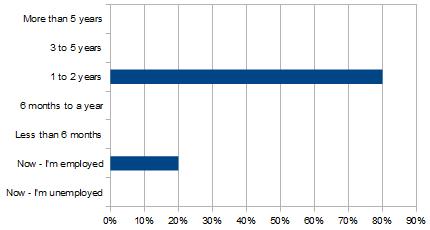It’s quite clear that readers have headed for the hills. That’s ok – we’re still here holding down the fort.
(by the way – has the fort ever really needed holding down?)
Of those that took the time to respond to July’s poll, most are set to work within their current profession for a year or two – let’s have a look.
Super-de-duper-majority
What do you call it when 80% of the respondents give the same answer – especially when they’ve got a choice among seven selections?!?
Overwhelming – that’s what!
Less believable results…
But really – many selections received no votes, and the total number of votes cast… Let’s just say I wasn’t digitally challenged to count up these answers.
One possibility is that folks are just plain gone – as in on vacation.
Another is that they just weren’t interested in answering this poll. But since I’m not partial to this interpretation, I’ll dismiss it as all good pollsters do. How about this vague sort of line:
We’re evaluating the results to determine if the question was asked in a manner that unintentionally skewed the results.
Whew – now doesn’t that sound just like poll-speak?-) So yes – when you see words like that, you can be confident that the poll wasn’t “right”, but the organization is running with it anyway.
Charts and such
Now brace yourself for this shocking graphic – it isn’t pretty.
Last month’s question – visitors were asked to respond to this:
The way things are going along, how long before you expect to make a career change?
Results of Career Change Poll
Marginally ok?
I mean – how else can one interpret this data? Most everybody is set in their current profession, and expects to make a change in a year or two.
I guess it would be bad if everyone wanted to make a change today – that would indicate a whole lot of pent up frustration.
And it would also probably not bode well if nobody was going to change until three or more years from now – that would be a whole lot of “I’m happy where I’m sitting” sort of attitude.
Care to comment?
Hey – let’s do like they do at the budding comic strip writer sessions. You know – present some sort of graphic with a balloon already there: “You make up the dialogue.”
Give me your best guess as to what this data tells us about the readers of The LinkedIn Personal Trainer. (and remember – no theory is too wild for this blog!)
Next up – how do you use LinkedIn?
That’s right. I’ve put up 11 different ways one can use LinkedIn. (actually 10 plus “other” to fit in ways that I haven’t thought of)
Check as many times as you identify wit, and let us know.
Find it just over to the right and up.
To your continued success,
steve
—
Steven Tylock
http://www.linkedinpersonaltrainer.com
http://www.linkedin.com/in/stevetylock

I NEED TO GET BACK INTO LINKEDIN….
I CANNOT GET YOU TO GIVE ME A PASSWORD!
Please help… William
William,
It sounds like you think that I have some ability to set your password on the LinkedIn.com site.
I’m sorry – I have no official (or unofficial) connection to the company or web site. I’m just an author / trainer who happens to know a whole lot about the site. (Heck, my standing joke is that if I was somehow on LinkedIn’s payroll, they’d probably have fired me by now;-)
But – presuming you’ve taken my advice and set a personal email as primary, you can just say “I’ve lost my password, please reset it”, and you’ll get an email with instructions from the nice folks over there at LinkedIn.
If you haven’t – and don’t have access to the primary email (because it’s an email address you had at some company you no longer work for), you’re stuck and have to find and use the “help center” button on the bottom of the LinkedIn site. From there you’ll want to click whatever you can to get to a “send a message to the help desk”, and outline your situation that way.
There isn’t much else to do…
Best of luck,
steve